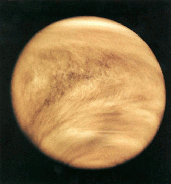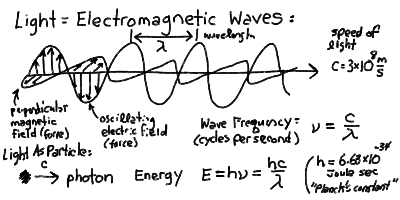 Solar System --- | ---
Temperature
Solar System --- | ---
Temperature

 Solar System --- | ---
Temperature
Solar System --- | ---
Temperature


Reading:
Chapter 2-1, 8-1 (ZG4)
 |
Key Question: | What determines the temperatures of the planets? |
|---|---|---|
 |
Key Principle: | Flux and Luminosity |
 |
Key Problem: | What is the flux of sunlight at 1 AU? |
 |
Key Quote: | "Some infinities are bigger than others." |
This topic was not covered in class, and will not be tested on, but forms the basis for the Theory of Electromagnetism. I present it here for your cultural benefit.
The 19th century scientist who played an analogous role for electricity and magnetism to what Isaac Newton did for gravity was the Scottish physicist James Clerk Maxwell (1831-1879). His four equations described the electic and magnetic forces just like Newton's equation described the gravitational force.
In fact, they are very similar. The electric force between two point charges is proportional to the product of the charges times the inverse square of the distances - just take Newton's gravitational force equation and replace the masses with charges, and change the constant! Note that because electric charge can be both positive and negative, the force can both attract and repel (like charges repel, opposites attract).
Maxwell found that there was a special solution to his 4 equations that corresponded to an oscillating electric and magnetic field which moves through space at the speed of light. He realised that this was exactly the description of light waves that was needed! In one fell swoop, he unified electromagnetism and light!
I presented a derivation of Maxwell's equations from Faraday's, Ampere's, and Gauss's Laws. I do not expect you to fully understand or be able to reproduce the details. Once again, this was included for your "cultural" benefit! These concepts are central to physics, and thus astrophysics, and if you come across them again in the future hopefully you will be able to make the connection.
Several pages of note on Maxwell's equations are in my lecture notes in the binder in the Math-Physics library, and available below in scanned JPEG form:
Maxwell's Equations - Page 1
Maxwell's Equations - Page 2
Maxwell's Equations - Page 3
I realize that most of you have not yet encountered vector calculus, namely the various derivatives of vector functions. I do not expect you to reproduce any of my derivations, but I thought (perhaps wrongly!) that it would be good for you to encounter this now. Should you come across it in Math 240, then you will know what it is good for!
I have prepared a two page primer on the subject. It is in my lecture notes in the binder in the Math-Physics library, and is available below in scanned JPEG form:
Vector Calculus - Page 1
Vector Calculus - Page 2
The electromagnetic wave, as described by Maxwell's equations, consists of mutually perpendicular harmonic electric and magnetic fields oscillating in phase and propagating in the orthogonal direction.
Almost everything we know about the Universe has been brought to us by the light that we observe with our instruments and eyes. Light, radio waves, radar, X-rays and ultraviolet rays are all examples of the same phenomenon of electromagnetic radiation. Light can be thought of as a electromagnetic wave with crests and troughs as in ocean waves (but without the ocean!). The things that are rising and falling in an electromagnetic wave are the electric and magnetic "fields", which rise and fall in step as a function of space and time. If we were to freeze time, and move along the direction of a wave, we would measure electric and magnetic forces that increased then decreased then changed direction and back again, like a sine wave. The distance between crests of the wave is called the wavelength and is measured in meters (or centimeters or nanometers, whatever is convenient). If one were to let time move normally, but measure the electric and magnetic forces as a wave passes by, then we would see the crests and troughs moving past us at the speed of light. Thus, we would see the waves pass us at the frequency of a certain number of cycles per second, say f, given by:
f = c / l
where l is meant to be the wavelength. We are familiar in using frequency to describe radio waves. When we say our favorite radio station has a frequency of 100 Megacycles (or MegaHertz), we mean that f = 100 x 10^6, that is 10^8, cycles per second. (Remember, mega means 10^6). Note that since the speed of light c = 3 x 10^8 m/s, that a frequency of 100 megacycles corresponds to a wavelength l = c/f = 3 meters.

The electric and magnetic forces in an electromagnetic wave are at right angles (perpendicular) to each other always.
The electric and magnetic forces from an electromagnetic wave, such as visible light or radio waves, can be measured. A radio wave, with a wavelength of 1 meter for example, can cause electrons in a wire of about that same length to move back and forth due to the oscillating electric force in the wave. These moving electrons are measureable as an electric current in the wire - this is how a radio or TV antenna works to receive signals!
The electrons in the metal of the antenna (which is basically just a long wire) are free to move a little in response to the radio wave electric field. The current alternates like a sine wave. The reverse is also true! If you oscillate the current like a sine wave in a long wire, an electromagnetic wave of the same frequency is generated. This is how radio and TV transmitters work.
Light can also be thought of as made up of particles, known as photons. Light is both a wave and a particle at the same time. The reconciliation of this dual nature has been one of the greatest breakthroughs in physics at the turn of the century. Each photon has a specific energy given proportional to the frequency of the wave that it corresponds to. The energy of a photon of frequency f is:
E = h f
where the constant h is known as Planck's constant. Planck's constant h = 6.63 × 10^-34 Joules sec.
There are many different energy photons, with energies ranging from zero to infinity, each corresponding to waves with wavelengths from infintely long to infintesimally small (zero). This is what is called the electromagnetic spectrum Radio waves, with wavelengths around 1 meter, are fundamentally the same as visible light, with wavelength around 500 nanometers (nm), the same as X-rays, with wavelengths around 1 nm. Because the photon energy is proportional to frequency, the high frequency, short wavelength radiation like UV and X-rays and Gamma Rays can actually do major damage to our bodies if we are exposed to it. It takes many microwaves (wavelength about 1 cm) to cook food in a microwave oven, because the photons each have very low energy. Nuclear explosions release large amounts of deadly Gamma Rays, each of which can do lots of molecular damage when they pass into organic material.
Different materials absorb specific frequencies of light. This is due to resonances with atomic and molecular structures as we will see later on. The air in the Earth's atmosphere absorbs the waves except special "windows" or wavelength bands where it is transparent. Both visible light and radio waves fall in these windows, so we can see out from the Earth into the heavens.
Just as electromagnetic waves of light are also particles (photons), all particles such as electrons and protons are waves! It turns out that a particle of momentum p has a wavelength of
l = h / p = h / mv
so more massive particles have smaller wavelenghths. This property is used in electron microscopes, which act like normal microscopes except using the wave nature of electrons instead of light. Because the wavelength of an electron wave is very very small, it can see smaller things than normal light based microscopes.
Every square meter of the Earth's surface receives a certain amount of sunlight, depending of course upon the time of day and the season. Consider a meter-square solar panel, which will convert the sunlight into electrical energy. Alternatively, we could also consider a meter-square panel of black absorbing material that would turn the sunlight into heat. In any event, when oriented perpendicular to the direction toward the Sun, such a panel will intercept the maximum amount of radiant solar energy. This can be measured as power in Watts --- Joules per second. If we were free of the Earth's atmosphere and had an unobstructed view of the Sun at a distance of 1 AU, we would find that we would intercept a particular flux of energy (in Watts per square meter). This is called the solar constant, and has the value of 1370 W/m^2.
Inclining the panel will reduce the intercepted power by the projected area, or
 )
)
where F is the solar constant, A the panel area, and
 the angle to the perpendicular.
the angle to the perpendicular.
Notice that we could in principle collect all of the Sun's emitted energy by constructing a sphere of radius R= 1 AU enclosing the Sun. Such a sci-fi construction is known as a Dyson sphere and every square meter of its surface would receive a flux equal to the solar constant F. The area of the sphere is 4 Pi R^2, so the Sun must be emitting a power, or luminosity L, of
For F=1370 watts/m^2 and R=1 AU=1.5 × 10^11 m, we find that the solar luminosity
 (1.5 × 1011 m)2 × (1370 W/m2)
= 4 × 1026 W.
(1.5 × 1011 m)2 × (1370 W/m2)
= 4 × 1026 W.
Notice that this relation between flux and luminosity will hold for spheres of any radius
 R2)
R2)
and so the flux falls off as the inverse square of the distance from the source, be it the Sun or a light bulb! For example, the solar flux at the orbit of Mars (R=1.524 AU) will be 0.43 times the solar constant at 1 AU.
 Prev Lecture ---
Prev Lecture ---
 Next Lecture ---
Next Lecture ---
 Astr11 Index ---
Astr11 Index ---
 Astr11 Home
Astr11 Home
smyers@nrao.edu Steven T. Myers